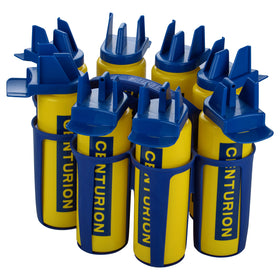Rugby Blog

History of Worcester Warriors
by Leana Kell
Worcester Rugby Club, nicknamed Warriors, are one of top rugby clubs in the country and currently play in the Aviva Premiership. The club is based in Worcester and has a stadium and training ground at Sixways Stadium. The traditional team colours are narrow band yellow on blue.
The Warriors were promoted to Premiership status in 2004 after winning the National Division One with a perfect record of 26 wins from 26 games, something never achieved before.
The club has moved in and out of the Premiership since 2004, but were last promoted in 2015 for the current season. Centurion takes a look below at the history of Worcester Warriors.
The Early Years
Worcester Warriors Rugby Club was founded in 1871 by the Reverend John Francis Ede. The club played their first match against the Royal Artillery Rugby Club on November 8th, 1871, with their first recorded victory against Gloucester College secured in the same season. In 1893, the club moved to Pitchcroft to a field adjoining Worcestershire County Cricket Club at New Road. Three years later, the club was disbanded. It was revived in 1908 and the club played matches at Pitchcroft and Northwick and annual meetings amongst the team began, until the onset of the First World War.
After the war, Worcester was reformed in 1920 and played their first match away at Bromsgrove. The team included a number of new players from Malvern, Droitwich, Pershore and Bromyard, as word spread across the district. The club became so popular, they had to form an A and B team to accommodate the growing numbers. When the Rugby Football League formed in 1922, Worcester entered the league in North Midlands Division One. The 1930s saw a very strong team develop and in the 1931/32 season, the club played 30 games, winning 27 of them.
The Grounds & Sixways
Due to issues with grounds, the club's early matches were played at a variety of locations to include Pitchcroft racecourse, until the team negotiated its own ground opposite the Ketch Inn in Kempsey, just before the onset of the Second World War. During the War, regular matches proved very difficult so the club made the decision to close down until 1945. Following the end of the War, the Worcester Warriors re-opened and secured more land at Claines where the first game was played in November.
The following year saw the club move yet again to Perdiswell by the canal, before the headquarters moving to the Old Talbot Hotel in Sidbury and the home ground to Bilford Road. Following a series of successful seasons, improvements were slowly made to the Bilford facilities to include a new shed to be used as the player's cloakroom and shelter.
In 1954, the club decided to look for new premises and soon they had purchased a ground at Bevere, with the official opening taking place on September 5, 1956.
The club continued to grow and entered the 1970s in a strong position, but the club still had to find a permanent home. A move to Sixway Stadium, the club's current home, was finally secured and the official opening of the new site took place on September 4th 1975.
In 2007, the Sixways stadium underwent massive improvement, and was renovated and expanded to include a health club, swimming pool and fitness centre on-site.
The 1960s, 70s & 80s
The club entered the 60s in a strong position with a new ground and facilities at Bevere, and the creation of five senior teams and two colt teams. In 1965, despite reports by the treasurer at the time that the club was in a very unstable financial position, membership continued to grow and by the 1966/67 season, the club had its best season to date with 27 victories under the leadership of Peter Baxter.
The club celebrated its centenary in 1971 and in the same decade made it to the Cup Final in 1976/1977, before sadly losing to Dudley. They finally secured the North Midlands Sevens title in 1977/78, and ended the seventies well with the first team going on a memorable tour to France.
Eager to keep the momentum of the club going, in the 1980s Warriors enjoyed success both at home and abroad. In 1980/81, the first team played 45 games and secured 19 wins and won the Worcester Sevens hosted at Sixways. International relations were cemented when the Warriors entertained the Fort Worth Rugby Club, and followed this up with a trip to America and a visit to Worcester, Massachusetts in 1987. The decade ended on a high when the Warriors finally reached the top of Division One.
The 90s and Cecil Duckworth
Worcester enjoyed success throughout the early nineties, rocketing up the leagues, which helped secure new training facilities at Sixways in 1995. The 90s also saw the arrival of Cecil Duckworth, a retired self-made millionaire and RAF pilot, who decided to plough much of his savings into the club in 1997. The funds allowed the club's squad to be rebuilt and the team was subsequently promoted to League One, which they won along with the North Midlands Cup and the Powerline Floodlit Cup.
In 1996, the game went professional and the club went full time under the leadership of Les Cusworth. The next few years saw the club be promoted and relegated from Division One until they finally reached the Premiership under the guidance of John Brain in 2004 after winning 26 out of their 26 games that season - a greater achievement than any other team has ever managed.
The Premiership
The first year in the Zurich Premiership proved to be a tough one for the Warriors, but they still managed to score a victory against reigning champions, the London Wasps amongst a handful of additionally impressive matches to include an end of season match against Northampton Saints that finished with a narrow victory of 21-19 to the Warriors.
In 2005/06, the club narrowly missed being relegated and went on to finish in a comfortable eighth place, a place higher than the previous year. In Europe, Warriors lost out to Gloucester in the semi-finals of the Challenge Cup at Kingsholm. The Warriors kept their place in the Premiership a further three years until they were relegated at the close of the 2009/10 season.
In 2010/11, the club achieved a superb season in the Championship under the leadership of new boss Richard Hill, and before long they were back in the Premiership, having topped the league winning 21 out of their 22 matches and all six of their pool matches. In 2011/12, the club secured a 10th place finish, beating the likes of Northampton Saints, Saracens and Bath Rugby to the finish.
2013 & Dean Ryan
Following a bad season in 2012/13, with just one win in the final 11 games, the Warriors finished one place above relegation, confirming the departure of Hill. Dean Ryan was appointed to replace Hill as Director of Rugby, and under his leadership, the focus of the club changed to ensure long-term success was within its grasp. Ryan began to target signings he could develop into top-end players such as Sam Smith, Ryan Mills and Nick Schonert in preparation for the 2014/15 season. Experienced players were also brought on board to include Welsh international Andries Pretorius, winger Tom Biggs and GJ van Velze who became captain. At the same time, Ryan worked with High Performance Director Nick Johnston to recruit necessary backroom staff to offer players off-the-field medical, nutrition and strength and conditioning support. In addition, the club launched six Junior Academy centres across the West Midlands and the wider region, so young players could be developed into first team stars.
2015 & Beyond
The Warriors enjoyed an incredible 2014/15 season winning the British and Irish Cup and Dean Ryan led the Warriors back into the Aviva Premiership ready for the 2015/16 season. Now the club is finally in the strongest position it has ever been in order to reach its long-term ambition to compete amongst European rugby's elite.




